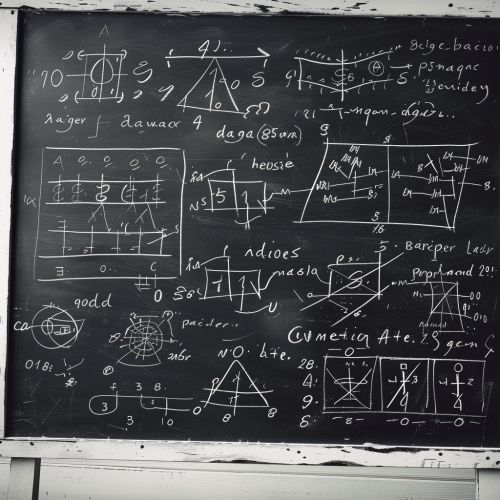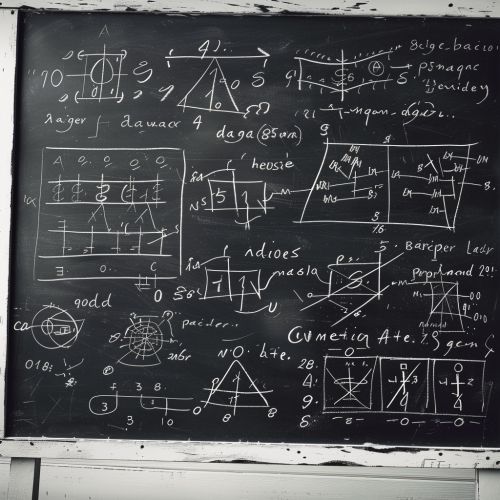Prime ideal
Definition and Basic Properties
In commutative algebra, a prime ideal is a subset of a ring that exhibits properties analogous to those of a prime number in the set of integers. Specifically, a prime ideal is an ideal \( P \) in a ring \( R \) such that if the product of two elements of \( R \) is in \( P \), then at least one of those elements must be in \( P \). Formally, an ideal \( P \) is prime if for any \( a, b \in R \), \( ab \in P \) implies \( a \in P \) or \( b \in P \).
Prime ideals play a crucial role in algebraic geometry and number theory, where they are used to generalize the notion of prime numbers to more complex algebraic structures.
Formal Definition
Let \( R \) be a commutative ring with unity. An ideal \( P \subseteq R \) is called a prime ideal if it satisfies the following conditions: 1. \( P \neq R \). 2. For any \( a, b \in R \), if \( ab \in P \), then \( a \in P \) or \( b \in P \).
This definition ensures that the quotient ring \( R/P \) is an integral domain, which means it has no zero divisors.
Examples
In the Ring of Integers
In the ring of integers \( \mathbb{Z} \), the prime ideals are precisely the ideals generated by prime numbers. For example, the ideal \( (5) \) is a prime ideal because if \( ab \in (5) \), then \( 5 \) divides \( ab \), implying that \( 5 \) divides \( a \) or \( b \).
Polynomial Rings
Consider the ring \( \mathbb{K}[x] \) of polynomials over a field \( \mathbb{K} \). An ideal \( (f(x)) \) is prime if and only if \( f(x) \) is an irreducible polynomial. For instance, in \( \mathbb{R}[x] \), the ideal \( (x^2 + 1) \) is prime because \( x^2 + 1 \) is irreducible over \( \mathbb{R} \).
Properties of Prime Ideals
Prime ideals have several important properties that make them fundamental in various areas of mathematics:
Localization
If \( P \) is a prime ideal in \( R \), the localization \( R_P \) is a local ring with the unique maximal ideal \( P R_P \). This property is essential in algebraic geometry, where local rings at prime ideals correspond to local properties of algebraic varieties.
Prime Spectrum
The set of all prime ideals of a ring \( R \), denoted by \( \text{Spec}(R) \), forms a topological space called the spectrum of a ring. The Zariski topology on \( \text{Spec}(R) \) is defined by taking the closed sets to be \( V(I) = \{ P \in \text{Spec}(R) \mid I \subseteq P \} \) for any ideal \( I \) of \( R \).
Prime Avoidance Lemma
The prime avoidance lemma states that if \( P_1, P_2, \ldots, P_n \) are prime ideals in \( R \) and \( I \) is an ideal such that \( I \subseteq P_1 \cup P_2 \cup \ldots \cup P_n \), then \( I \subseteq P_i \) for some \( i \). This lemma is useful in commutative algebra and algebraic geometry for simplifying the structure of ideals.
Prime Ideals in Non-Commutative Rings
While the concept of prime ideals is most commonly discussed in the context of commutative rings, it can be extended to non-commutative rings. In a non-commutative ring \( R \), an ideal \( P \) is prime if for any ideals \( A \) and \( B \) of \( R \), \( AB \subseteq P \) implies \( A \subseteq P \) or \( B \subseteq P \). The study of prime ideals in non-commutative rings is more complex and involves additional considerations.
Applications
Prime ideals are instrumental in various mathematical disciplines:
Algebraic Geometry
In algebraic geometry, prime ideals correspond to irreducible varieties. The points of an algebraic variety are often associated with prime ideals in the coordinate ring of the variety. This correspondence is foundational to the geometric interpretation of algebraic structures.
Number Theory
In number theory, prime ideals generalize the notion of prime numbers to rings of integers in number fields. The study of prime ideals in these rings leads to important results in algebraic number theory, such as the unique factorization of ideals.
Homological Algebra
Prime ideals are used in homological algebra to define and study various cohomological invariants. For example, the support of a module over a ring is defined in terms of the prime ideals in the ring.
See Also
- Ideal
- Maximal ideal
- Integral domain
- Localization of a ring
- Spectrum of a ring
- Algebraic variety
- Ring of integers
- Irreducible polynomial


